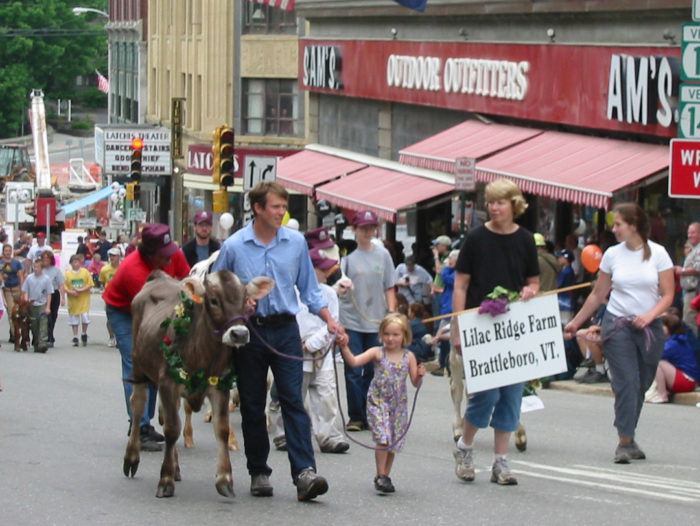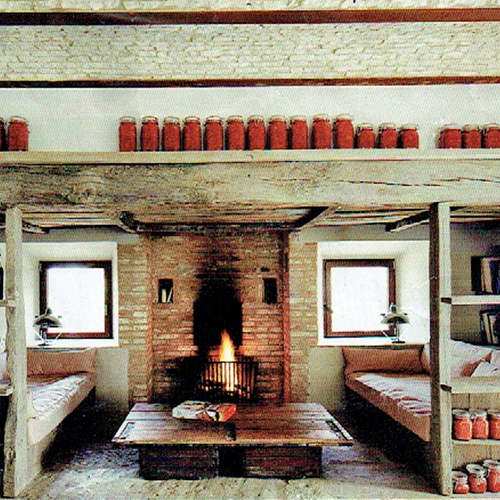Image Credit: Alex Wilson
Image Credit: Alex Wilson A session at last year's Slow Living Summit.
Image Credit: Jesse Baker The just-published 2013 Locavore Index.
Image Credit: Strolling of the Heifers
For the past three years, the Slow Living Summit has been an important ancillary event to the Strolling of the Heifers parade in Brattleboro, Vermont, which is now one of the state’s leading tourist attractions. With a nod to Spain’s famous Running of the Bulls, the Strolling of the Heifers is a relaxed walk along Main Street that focuses attention on farmers and local food.
Right from day one, Strolling organizer Orly Munzing worked to provide an educational component to the event. So it was a logical extension to host a focused conference that tied into the Strolling.
But the Slow Living Summit, whose program committee I’ve participated in these three years, goes beyond food and agriculture.
Celebrating the idea of slowing down
The Slow Living Summit was inspired by the Slow Food movement in Europe — an effort to counter “fast food,” which is continuing to grow in dominance (approximately 19% of our meals are consumed in cars, according to Michael Pollan) — and the Slow Money movement, which is focused on local economies, local investing, and slowing down the pace and scale of the world of banking and finance. “Slow living” seeks to tie these together.
From the Slow Living Summit website:
’Slow’ encompasses several layers of meaning that go beyond simply ‘sustainable.’ Slow is the opposite of ‘fast’ — fast food, fast money, fast living — and all of the negative consequences ‘fast’ has had for the environment and for the health of people and societies. ‘Slow’ embodies cooperation, respect, sustainability, gratitude and resilience.
The conference is schedule for this Wednesday through Friday
The Slow Living Summit in Brattleboro begins Wednesday evening with registration, exhibits and networking in the Latchis Hotel lobby, a reception at 5:00 at the Latchis main theater, and the opening plenary beginning there at 6:30 pm.
Speakers in the opening plenary will be Jonathan Lash, the president of Hampshire College and past president of the World Resources Institute, and Robert Repetto, a senior fellow at the World Resources Institute. There will also be remembrances of two local advocates of slow living, who passed away within the past year: Helen Daly and Keith Maillard.
Other plenary sessions during the conference include:
Thursday morning, 8:30-10:00 – “Agriculture, Food, and Food Systems: Reconnecting Farmers, Eaters, and Healthy Communities” with Frances Moore Lappé, author of Diet for a Small Planet, and Judy Wicks, author of Good Morning, Beautiful Business: The Unexpected Journey of an Activist Entrepreneur and Local-Economy Pioneer. Wicks is also founder of the White Dog Café, Philadelphia, and a co-founder of Business Alliance for Local Living Economies (BALLE).
Thursday afternoon, 1:45-3:15 – “Slow Design: The impact of mindful design on the quality of public spaces and their communities” with Jonathan Fogelson of the Michael Singer Studio; Roseanne Haggerty, president of Community Solutions in New York City; and Rasmia Kirmany-Fry, director of the Brownsville Partnership, a program of Community Solutions.
Friday morning, 8:30-10:00 – “Transitioning to a New Economy,” with presenters Gus Speth of the Vermont Law School and previously the Yale School of Forestry and Environmental Studies; Tina Clark, a Massachusetts Transition Town trainer; and Chuck Collins of the Institute for Policy Studies.
All of the plenary sessions are open to the public with a suggested donation.
The Slow Living Summit also includes four periods, each with a selection of seven to nine breakout sessions to choose from. These in-depth and highly interactive sessions are being held in the Marlboro Graduate Center, smaller Latchis theaters, and the Brattleboro Food Co-op Community Room. To participate in these sessions requires a full or one-day conference registration.
The breakout sessions include everything from new models of farm cooperatives with Roger Allbee, a past Vermont Secretary of Agriculture, to a session on the “Story of Place” with Kate Stephenson of Yestermorrow, and Bill Reed of the Regenesis Group; an update on nutrient cycling through urine-separation technology, which is being pioneered in Brattleboro (including field trials); and “resilient design” that Bob Stevens and I are presenting that will highlight several local projects.
The Locavore Index
With the growing interest in local food and agriculture, the organizers of the Strolling of the Heifers and Slow Living Summit rolled out the Locavore Index in 2012. This metric factors in farmers’ markets, community supported agriculture (CSA) operations, and food hubs, and normalizes an index of those operations by population to rank states according to the availability of local food and agriculture. The metric may not be perfect, but it’s a start at reporting statistics on food production that aren’t often considered.
For the second year in a row, Vermont came out ahead in the 2013 Locavore Index, followed by Maine, New Hampshire, North Dakota, and Iowa (see attached chart). Indeed, some of the results are surprising, while others may not be. Bringing up the bottom of the list are Texas, Florida, Louisiana, Arizona, and Nevada.
A model for other regional events
The Slow Living Summit in the small town of Brattleboro, is a different sort of conference — one that is integrated into the downtown, rather than being housed in a sterile conference center somewhere. Participants will walk through the downtown getting from one venue to another and to the lunch venue.
That some attendees are coming from afar may seem contradictory. The Summit is inherently about localism, but sometimes in achieving locally based solutions we have to look at what’s being done somewhere else. That’s what’s bringing attendees to the Slow Living Summit from distant states and even some foreign countries. And if these attendees take the Slow Living Summit model back home and implement it there, our event will be a success.
With the Slow Living Summit — and the Strolling of the Heifers parade immediately following on Saturday — Brattleboro is at the leading edge of the transition to a more locally based, sustainable, and resilient future. Come and enjoy our town and these wonderful events.
Alex is founder of BuildingGreen, Inc. and executive editor of Environmental Building News. In 2012 he founded the Resilient Design Institute. To keep up with Alex’s latest articles and musings, you can sign up for his Twitter feed.
Weekly Newsletter
Get building science and energy efficiency advice, plus special offers, in your inbox.













3 Comments
biased opinion
Do I sense a bias in VT being #1 on the Locavore list? We flatlanders know how to grow and eat locally too you know!
Locavore index
Bias? Perhaps. I think the index is pretty limited in that it doesn't factor in total food production and food consumption by a state--which would indicate potential for local food sourcing. I'd like to see a more robust index that addressed this, and I suspect that Vermont wouldn't achieve top ranking.
That said, I think it's a great idea to produce such a ranking and report the findings annually.
Faster communities
Like most of us I work in the "fast" world and have to get as much slow living as I can at home. BTW, having grown up on a farm ( just a few miles WSW of your location, across the border) I can attest that there are times when the pace can be plenty quick.
But I have discovered a real benefit from my extensive backyard gardening habit. I call it ASC, Agriculture Supported Community. Gardens don't produce based on your ability consume and some crops are either hard to preserve and/or best when really fresh.
Starting with the early greens, asparagus, rhubarb and strawberries I visit my neighbors with the excess. A container of free asparagus is always well received and usually when I stop by I get invited to sit down, share a beverage and chat. I know my neighbors and their families. I learn about community events, I find out who might need the produce a little more right now and all the mundane details that are the fabric of a community.
While everyone says it seems like a lot of work to maintain my edible landscape, the effort may be physically tiring but it refreshes the spirit better than anything I have found.
How does this relate to the conference themes? Physical community design. I live in an older neighborhood on a 2/3 acre lot and the adjoining lots are odd sized, small and not uniform. That makes more physical connections. My lot touches six others, not counting the two across the street. If you want opportunity for interaction having five acre lots with the only community connection being the driveway is not the way to go.
When I look at development plans for residential neighborhoods I seldom see opportunities for accidental interaction. Privacy is important, but sharing a backyard that runs unimpeded into your neighbors is a chance to interact. We need to relax a bit about needing exact measurements on lot size and frontage and give people a chance to work out their relationships with their neighbors.
Here's a tip; grow a garden. Your neighbors will love to see you coming to the door.
Log in or create an account to post a comment.
Sign up Log in